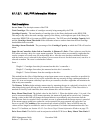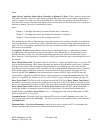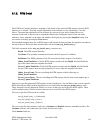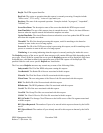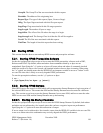Server to set the VV Condition of the associated tape volume to DOWN. Once in DOWN state, the
volume will no longer be available for read or write operations. For further information about the Core
Server VV Condition, see Section 4.5.4.2: Core Server Tape Volume Information Window on page 271.
Drive Error Limit. This field is used in conjunction with the PVR Server Retry Mount Time Limit. If
the number of consecutive mount errors which occur to any drive in this PVR equal or exceed this value,
the drive is automatically locked by the PVL. The only mount errors that apply are those set through the
Retry Mount Time Limit mechanism. The Drive Error Count field in the PVL Drive Information
records the number of consecutive errors on a drive by drive basis. To turn off the automatic drive
disable feature, set the Drive Error Limit to 0 or -1. Changing its value will not change drive disable
behavior until the PVL is recycled.
ACSLS Packet Version. The packet version used by STK’s ACSLS software.
Alternate SSI Port. A site running two SSI (Server System Interface) services on the same platform will
specify the non-default port number of the second service via this field. Refer to Section 5.1.1.1.1: STK
PVR Additional Information on page 121.
Dismount Delay. When Defer Dismounts is checked, this value is used by the PVL to determine the
number of minutes that dismounts are delayed after the last data access.
Shelf Tape Check-In Retry. The number of seconds the PVR will wait before asking the robot if a
requested shelf tape has been checked-in. The PVR will continue checking at this interval until the tape is
checked-in. This field applies only if the Support Shelf Tape checkbox is selected. The retry value must
be 30 or greater.
Shelf Tape Check-In Alarm. The PVR will periodically log alarm messages when a requested shelf tape
has not been checked-in. This field specifies the number of minutes between alarms. This field is only
active if the Support Shelf Tape checkbox is selected. The alarm value must be 2 or greater.
Characteristics. Flags for the PVR:
• Defer Dismounts. If ON, the PVL will delay the dismounting of a tape cartridge until the
drive is required by another job or until the Dismount Delay time limit is exceeded.
• Support Shelf Tape. If ON, the PVR and the PVL will support the removal of cartridges
from the tape library using the shelf_tape utility.
5.1. Real-Time Monitoring (RTM)
Real-time Monitoring (RTM) is a facility built
R
into the Gatekeeper, the Core Server, and the Mover.
Whenever an HPSS thread acting on behalf of a user job or a high-level system activity
t
needs to block or
process an operation that may take some time to
p
complete, it will create an RTM record with information
about what it is
a
currently doing or waiting for. The RTM utility (rtmu) can be used to
c
query the list of the
current requests and obtain pertinent data for
c
each request. The RTM requests can be used to construct an
overview of
o
the current operations being processed by the HPSS system as well as to monitor the overall
health and status of the system. RTM requests that remain in the system for an extended period of time
may indicate that the system is under heavy load.
m
If a request remains for an unusually long time, it may
indicate a
i
hang condition or a deadlock situation that may require special
h
intervention.
i
HPSS Management Guide November 2009
Release 7.3 (Revision 1.0) 144





